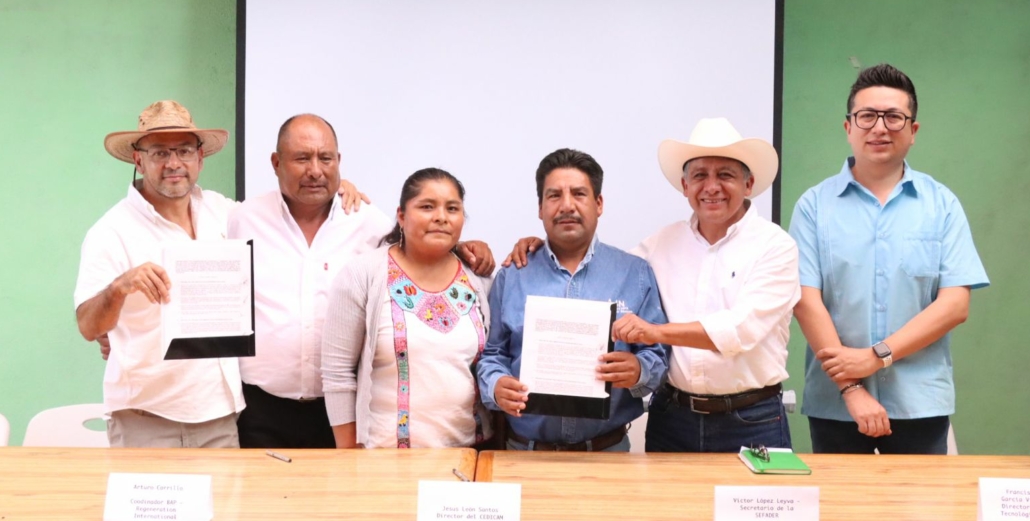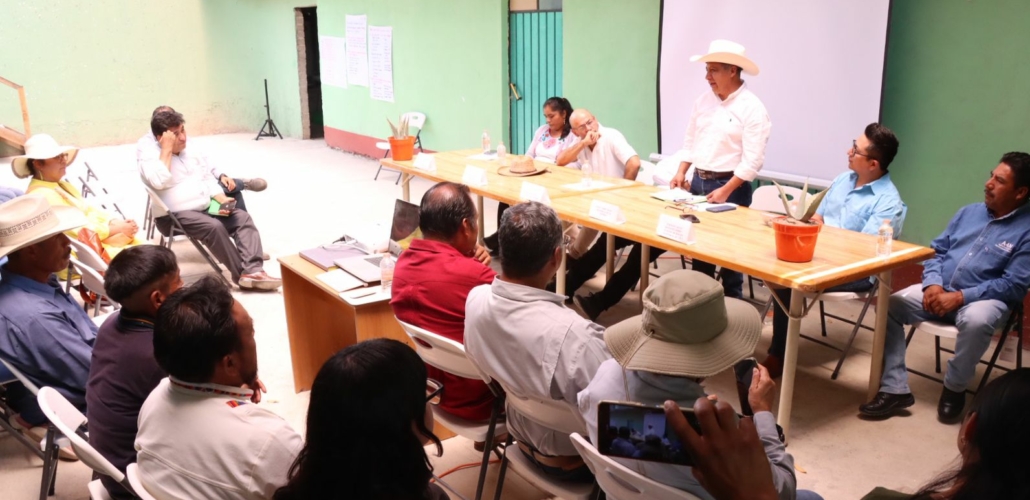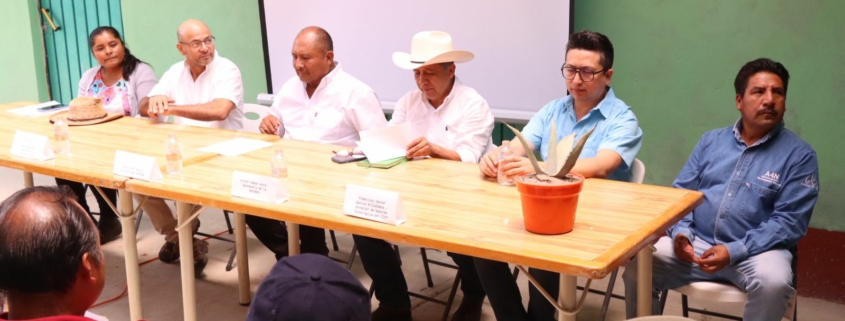The Billion Agave Project Expanding to the Mixteca Region
Biocultural recovery based on environmentally, socially and economically sustainable productive projects.
- The Secretary of SEFADER and other personalities assisted the event, a collaboration agreement was signed between Regeneration International and CEDICAM.
- Agave and its multiple uses, a driving force for sustainable development in the region
- The social, academic, public and private sectors join the project
On April 9, 2024, at the Center of Integral Campesino Development of La Mixteca (CEDICAM) in Asunción de Nochixtlán, Oaxaca, Mexico, Regeneration International (RI) and CEDICAM signed a collaboration agreement to implement the Billion Agave Project (BAP) in the Mixteca, a region with a strong presence of indigenous communities and a significant loss of biodiversity due to erosion and climate change, among other factors.
CEDICAM is a campesino organization made up of Mixtec indigenous people with a solid track record of social and environmental commitment. Since 1997 it has worked on the implementation of sustainable agriculture, the promotion of good nutrition, health care, soil conservation and the reforestation of thousands of hectares of forest, work that has earned its founder and general director, Jesús León Santos, the 2008 Goldman Prize.
The BAP, with a focus on economic, social and environmental sustainability and in collaboration with the social, community, academic, private and public sectors, aims to contribute to the preservation of the environment and the holistic improvement of living conditions in the communities, through the creation and implementation of various wide-ranging productive projects that take full advantage of and add value to one of the most deeply rooted crops in Oaxacan culture: agaves.
One of the main reasons why the BAP has aroused the interest of Mixtec communities is that it offers a viable solution to one of the main problems facing the region: the loss of the ecosystem’s capacity to provide sufficient feed for productive animals. This fact forces farmers to reduce or even abandon animal husbandry, as the purchase of feed is not an option for most people, given the weak economic situation faced in the region. Most worryingly, the difficulty or impossibility of raising animals puts the food security of the indigenous communities of the Mixteca at risk.
Addressing this problem, the BAP proposes agroecological model plantations based on agave, leucaena and other species -all of them with millenary cultural roots- to produce a feed of high nutritional value for animals, such as agave silage enriched with legume protein. The advantages of this project, among others such as soil improvement and carbon sequestration, are that both water demand and costs are significantly low. In addition, the agave landscape that once characterized the Mixteca would be recovered, and with it, the possibility of obtaining mead for tepache and pulque, and stalks for barbecue, which are uses, among many others, that have ancestrally occurred in the area.
The event was attended by the general director of CEDICAM, Jesús León Santos, the coordinator of the BAP, Arturo Carrillo, the director of Technology Management of the Center for Scientific Research of Yucatán (CICY), Javier García Villalobos, the representative of the indigenous communities of the Mixteca, Maximina Montesinos Santiago, the president of the Board of Directors of CEDICAM, Elaeazar García Jiménez, and the head of the Ministry of Agri-Food Promotion and Rural Development of Oaxaca (SEFADER), Víctor López Leyva.

(from left to right) Luis Arturo Carrillo Sánchez, BAP coordinator; Jesús León Santos, general director of CEDICAM; Maximina Montesinos Santiago, representative of the indigenous communities of the Mixteca; Elaeazar García Jiménez, president of the CEDICAM Board of Directors; Víctor López Leyva, secretary of SEFADER and Javier García Villalobos, director of Technology Management at CICY.
During the presentation, Jesús León Santos commented that the signing of the agreement between RI and CEDICAM means the start of a very important process for the Mixteca, where the presence of rainfall is limited and therefore peasant agriculture is always at risk due to drought, early frosts and poor soils. A project that focuses its efforts on the intercropping of agaves and forage forest trees sets a very important precedent, because they are plants that are able to adapt to conditions of low rainfall and develop in soils poor in organic matter. On the other hand, it represents an opportunity to conserve such an important species as the pulque agaves, linked to the peasant culture, not only for the pulque, but for all the products and by-products obtained from this plant. In this way, while generating a mechanism for the integral use of both agaves and fodder trees, it can generate economic opportunities for the farming families of the region, and he added that CEDICAM, together with RI and the participating farmers, will use all our capacities so that this project contributes to the recovery of the landscape and the improvement in the quality of life of the families.
In his speech, Arturo Carrillo also explained that the BAP consists of implementing various agave production and marketing projects that recover the culture of integral use that the native communities have had since long ago and that generate sustainable economic, environmental and social solutions in the regions where they are implemented. He added that the strategy is to develop these projects initially in five implementation hubs: 1) the Vía Orgánica Ranch in San Miguel de Allende, Guanajuato, 2) at the ranch El Mexicano in collaboration with Sarape CircuLab in Guadalajara, Jalisco; 3) at the Hacienda Sotuta de Peón in Yucatán; 4) in Suchixtlán, Oaxaca with the Koch Foundation and 5) at CEDICAM in Nochixtlán, Oaxaca. He also mentioned that some of these productive projects are the extraction and commercialization of inulin and lactic acid, the formulation of feed for productive and affective animals, the production of fermented and distilled products, and the production of molasses and syrup, among others, and all of them are being developed based on scientific and technological research of the highest level in collaboration with institutions such as the CICY or the Center for Research and Assistance in Technology and Design of the State of Jalisco (CIATEJ) and in close relationship with the native communities, who possess invaluable ancestral knowledge about their territory. He concluded by commenting that this type of project can only be developed in a harmonious collaboration between the social, community, academic, private and public sectors, for this reason -he stressed- an indispensable component on which we are working hard, is the link with these sectors.
Javier García Villalobos commented that CICY has made clear its intention to participate in the Billion Agave Project not only in the Yucatán region, but also in the state of Oaxaca. Particularly for the Mixtec region, CICY proposes, on one hand, to develop projects for the holistic use of both mezcal agaves and magueys to produce pulque, as well as to be a supplier of the plants for the implementation of the project, which will be produced in its Biofactory “Dr. Manuel L. Robert” and that present characteristics that provide advantages to the different segments of the value chain such as: reduction in the time for their maturation and the conservation of the organoleptic characteristics necessary for the production of by-products from these crops of national and international importance, just to mention a few.
In her turn, Maximina Montesinos Santiago commented that from the position of the women of the communities of the Mixteca region, the implementation of a project of this type will contribute significantly to the recovery of the soil and it is expected to improve the economy of the participating families, but more importantly, it will strengthen our culture linked to the agaves, such as the food, medicinal and related aspects of our local traditions. On the other hand, there are undoubtedly many products that can be obtained from agaves and this represents a great opportunity for our people and especially for women, in a region where there is no income due to lack of job opportunities, the mere fact of producing fodder from agaves, can profoundly change our culture of feeding our animals, providing them with better quality fodder. We women joined this project with the hope of changing our situation and demonstrating that it is possible to improve our quality of life through our ancestral crops.

Eleazar García commented that the agreement being signed will be of great benefit to the region and that CEDICAM will do everything possible to contribute to its success.
To close the speeches, the Secretary of SEFADER, Víctor López Leyva, expressed that the recovery of the agave culture in Oaxaca constitutes the opportunity to provide concrete answers of responsible development to the issues of environmental deterioration caused by deforestation and the careless opening of new territories to the cultivation of mezcal magueys, He concluded by affirming that “when an alliance is made with academia, the public and private sectors to rescue productive activities related to agaves, their preservation and durability, we are undoubtedly on the road to doing justice to the Oaxacan countryside”.
Also in attendance were several municipal presidents from the region and thirty community representatives.
To close the event, a delicious Mixteco-style barbecue was offered as a meal, accompanied by handmade native corn tortillas and pulque and tepache as a beverage.

